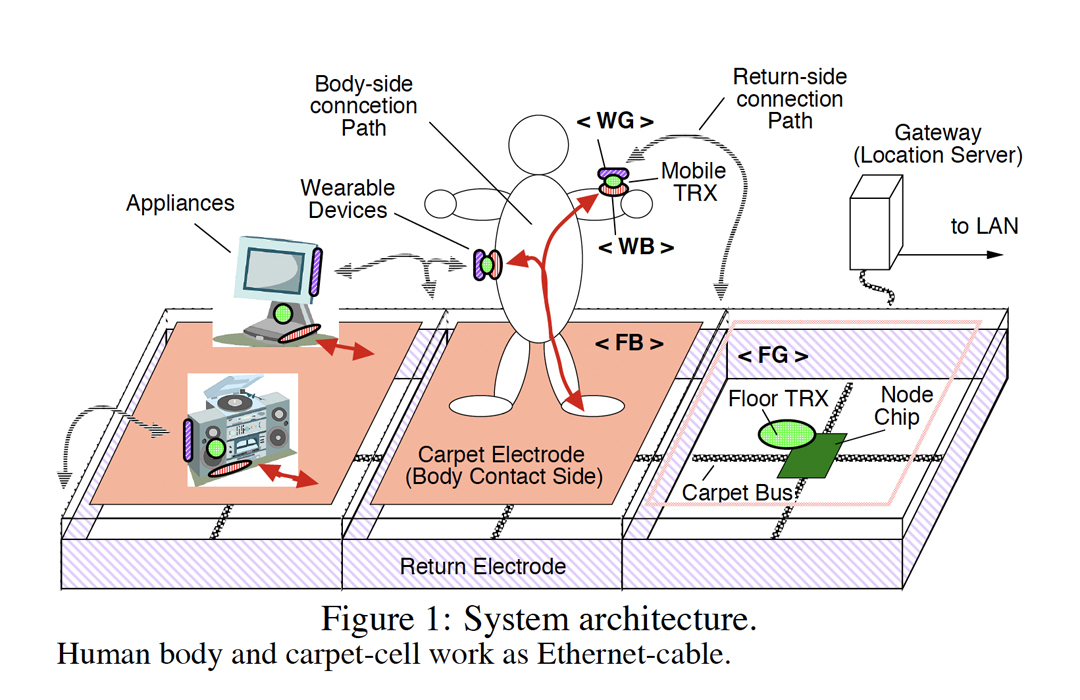““ElectAura-Net”: An indoor wireless(-like) networking and positioning system for ubiquitous world” by Fukumoto, Shinagawa, Ochiai and Sugimura
Conference:
- SIGGRAPH 2003
-
More from SIGGRAPH 2003:


Type(s):
E-Tech Type(s):
- Electronics
- Networking
- Wearables
Entry Number: 06
Title:
- “ElectAura-Net”: An indoor wireless(-like) networking and positioning system for ubiquitous world
Presenter(s):
Project Affiliation:
- NTT DoCoMo Multimdia Labs and NTT Microsystem Integration Labs
Description:
1 Introduction
“ElectAura-Net” is a novel indoor broad-band networking and positioning system. It enables wireless(-like) high-speed networking by using electric fields (= Electric Aura) as a transmission media, and the human body and floor as an Ethernet-cable. A new Electro- Optic(EO) sensor realizes broadband (10Mbps) intrabody communication between bodyworn and floor-mounted devices. ElectAura- Net also provides an indoor positioning function, which is urgently needed for realizing “ubiquitous” communication.
2 ElectAura-Net
The system structure of ElectAura-Net is shown in Figure 1. There are two types of transceivers; one is mobile devices such as wearables, PDAs and appliances; the other is environmental devices mounted on floors, walls, and ceilings. A pair of electrodes is placed on the body-contact side (WB) and the opposite (untouchable) side (WG) of a mobile transceiver. Another pair of electrodes is placed on foot-contact floor carpet (FB) and the surrounding (untouchable) part (FG) of the floor transceiver. Every carpet has its own node, and all nodes are connected to each other; groups of carpets are connected to outside networks via gateway(s).
When a signal is transmitted from a mobile device to the floor device, a high-speed switching voltage signal is applied between both electrodes of the mobile transceiver (WB-WG). The surrounding electric field of the mobile transceiver is changed by the signal. The human body has good conductivity for high-frequency (over 10kHz) electric signal, so it can be considered as an electric wire. Thus, the electric-field from the WB electrode is conveyed through the body to the floor electrode FB. On the other hand, the electricfield from the electrode WG leaks into the surrounding space, and reaches the floor electrode FG via air. Therefore, the transmitted signal can be decoded from the electric-field that appears between the floor electrodes (FB and FG).
In addition, mobile transceivers can be mounted on other devices such as computers or appliances, and an instant network connection can be established simply by “putting” the device on the floor.
Ordinary “electric-field” communication system used FET devices as the electric field sensor [Zimmerman 1996], and the maximum communication speed was about 40kbps [Partridge et al. 2001]. On the other hand, ElectAura-Net uses a new Electro-Optic (EO) crystal [Shinagawa et al. 2001], which has high sensitivity and high-speed operation capability. 10Mbps speed TCP-IP communication is confirmed between bodyworn and floor-mounted devices. PDA style and floor-mounted transceivers are shown in Figure 2.
ElectAura-Net also enables accurate positioning in indoors. Each carpet works as “communication cell”. Unlike radiowavebased systems such as wireless-LAN, cell size can be reduced up to 1-meter or less without interference. The location of a mobile device (= carpet on which it stands) can be detected by simple commands such as “traceroute”. No special circuit is needed for positioning.
Other Information:
References
PARTRIDGE, K. et al. 2001. Emprical measurements of intrabody communication performance under varied physical configurations. In Proceedings of ACM UIST 2001, 183–190.
SHINAGAWA, M. et al. 2001. A real-time electro-optic handy probe using a continuous-wave laser. In IEEE Trans. Instrum. Meas., vol. 50, No. 5, 1076–1080.
ZIMMERMAN, T. 1996. Personal area networks: Near-field intrabody communication. In IBM Systems Journal, vol. 35, NOS 3&4, 609–617.





